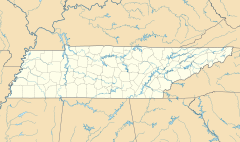Central Station (Memphis)
|
Memphis Central Station
|
|||||||||||
|---|---|---|---|---|---|---|---|---|---|---|---|
 |
|||||||||||
| Location | 545 S. Main Street Memphis, TN 38103 United States |
||||||||||
| Coordinates | 35°07′56″N 90°03′34″W / 35.1323°N 90.0594°WCoordinates: 35°07′56″N 90°03′34″W / 35.1323°N 90.0594°W | ||||||||||
| Owned by | Memphis Area Transit Authority | ||||||||||
| Line(s) | Illinois Central (CN) | ||||||||||
| Platforms | 1 side platform | ||||||||||
| Tracks | 2 | ||||||||||
| Connections | MATA Riverfront Loop | ||||||||||
| Construction | |||||||||||
| Parking | Yes | ||||||||||
| Bicycle facilities | Yes | ||||||||||
| Disabled access | Yes | ||||||||||
| Other information | |||||||||||
| Station code | MEM | ||||||||||
| History | |||||||||||
| Opened | 1914 | ||||||||||
| Rebuilt | 1999 | ||||||||||
| Traffic | |||||||||||
| Passengers (2013) | 76,171 |
||||||||||
| Services | |||||||||||
|
|||||||||||
| Location | |||||||||||
Memphis Central Station, referred to as Grand Central Station prior to 1944, is a passenger terminal in Memphis, Tennessee. Located along Main Street and G.E. Patterson Boulevard in Downtown Memphis, it currently serves Amtrak's City of New Orleans route and the MATA Trolley system. The building opened in 1914
Central Station was built on the site of a former station known as Calhoun Street Station. Both stations were owned by the Illinois Central Railroad or its predecessors. Construction of Memphis Central Station began in September 1912, and the station was opened for service on October 4, 1914. The track design included five stub-end tracks (station tracks 1-5), and five through tracks (station tracks 6-10).
Memphis Central Station was owned by Illinois Central Railroad and the station was also used by Yazoo and Mississippi Valley Railroad, St. Louis-San Francisco Railway, and Chicago, Rock Island and Pacific Railway. Between April 1, 1964, and November 30, 1966, the Louisville and Nashville Railroad was also a tenant, during the time that Memphis Union Station was closed.
Lavender v. Kurn, 327 U.S. 645 (1946) was a case decided by the Supreme Court of the United States dealing with a negligent wrongful death case against a railroad employer under the station. The relatives of the switchtender sued for negligence under the Federal Employers Liability Act and the Supreme Court upheld the claim.
...
Wikipedia

